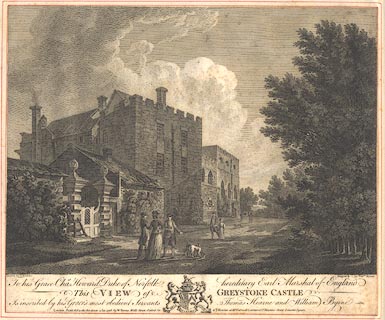

Dove Cottage : Lowther.70
image:-
© see bottom of page

click to enlarge
Plate 1 ?from the Antiquities of Great Britain, published 1786-1807.
Blazon of the first quarter in the quartered part of coat of arms is the Howard Family's 'gules on a bend between six cross crosslets fitchee argent on an escutcheon thereon a demi-lion rampart pierced through the mouth with an arrow within a double tressure flory counterflory'.
Pasted in the Lowther scrapbook, vol.4; at the start, before p.361; with descriptive text:-
GREYSTOKE CASTLE. / This Castle, under which, the lands within that part of Cumberland called the Barony of Greystoke were held by military tenure, takes its name from Cray or Craig, a Rock, and Stoke, a Place. / Ranulph de Meschines, the great northern Grantee from William the Conqueror, gave this Barony to Lyulph, a Saxon Lord, who had been of great note in the time of Edward the Confessor, and in whose male line it continued for many years, during which time they were summoned to Parliament as Barons of Greystoke. / In the reign of Henry VII. Elizabeth, the Grand-daughter of the last Lord of Greystoke, was married to Thomas Lord Dacre of Gillesland, in whose family it continued till the reign of Queen Elizabeth; when this Castle and Barony were, upon a division, assigned to Ann, sister and co-heir of George, the last Lord Dacre, who was married to Philip, eldest son of Thomas Howard, Duke of Norfolk, to whose male heir it now belongs. / The ancient part of this Castle was built by William Lord Greystoke, who was surnamed the Good: he died in the 32d of Edward III. and was buried with great solemnity in the chancel of the parish church of this place. / The old castle is said to have been originally quadrangular, uniting four Towers and a Gate-way. The greatest part of it was burnt in the civil wars, during the reign of Charles I. however, there yet remains two of the old Towers, one of which is entire, of three Stories in height, and contains six Bed-chambers, and a large Vault or Dungeon below, formerly a Prison, now made use of as a Wine-cellar. / The ancient Tower, which is the principal object in the Print, is obliquely situated with respect to the other parts of the Castle, the chief part of which was rebuilt and modernized in the beginning of this century. / The Drawing was taken in the year 1777.
Drawn by T. Hearne / Engrav'd by Willm. Byrne / To his Grace Chas. Howard Duke of Norfolk, hereditary Earl Marshal of England This VIEW of GREYSTOKE CASTLE Is inscribed by his Grace's most obedient Servants Thomas Hearne and William Byrne. London. Published as the Act directs, 1 Jan 1778, by W. Byrne, Wells Street, Oxford Str. & T. Hearne, at Mr. Mr. Garvock's, corner of St. Martin's Street, Leicester Square.
coat of arms
from:-
Scrapbook, 4 volumes, History of Westmorland and Cumberland Illustrated, of descriptive texts, maps, and prints of views and coats of arms, for Westmorland and Cumberland, assembled by a member of the Lowther Family, late 18th early 19th century.
The volumes are quarter bound, with marbled paper on the covers; each has a bookplate inside the front cover. The pages cut from various sources are nicely mounted, two sided pieces set neatly in a window in the scrapbook page.
The main content is the whole of the two volumes of The History and Antiquities of the Counties of Westmorland and Cumberland, by Joseph Nicolson and Richard Burn, published London, 1777. Nicolson and Burn volume 1 is in scrapbook volumes 1 and 2, volume 2 in scrapbook volumes 3 and 4. Maps and prints are interspersed to make an illustrated version of the history.
Some of the sources of maps and prints have been recognised:-
Maps - coast of Cumberland etc by Andrew Dury, 1764; Westmorland and Cumberland by Richard Blome, 1673; sheets from Britannia Depicta, Emanuel Bowen, 1720; Cumberland by John Speed, Henry Overton edn 1695; Cumberland by John Cary 1787.
Prints from the Set of prints, 20 engravings, Views of the Lakes etc in Cumberland and Westmorland, drawn by Joseph Farington, published by William Byrne, London, 1789. Note that plate numbers vary from edition to edition of this set.
Prints from the Antiquities of Great Britain, drawings by Thomas Hearne, engraved by William Byrne, published by Hearne and Byrne, London, 1786-1807.
Prints from Britannia Illustrata, drawings by Leonard Knyff, engraved by John Kip, published London, 1707-1740.
Print from A Tour in England and Scotland, by Thomas Newte, published by G G J and J Robinson, Paternoster Row, London, 1788..
Some of the coat of arms are cut from A Display of Heraldrie by John Guillim late Pursuivant at Armes, published London, about 1610-11 to 1755.
Coats of arms probably from The Baronetage of England, by Edward Kimber and Richard Johnson, published London? 1771.
Pages from The Antiquarian Repertory, by Francis Grose, Thomas Astle, et al, published London, 1775-1809.
Text from the Baronetage of England by Collins?
Scraps cut from an unidentified gazetteer.
At the end is the title page and pp.7-51 from A General View of the Agriculture of the County of Cumberland, by John Bailey and George Culley, published by C Macrae, London, 1794.
Individual maps and prints are documented separately; with a note of their position in the scrapbooks.
inscription:- : embossed: label on spine: (tatty remains): HI[ ] / [ ]/WEST[ ]M[ ] / [ ] / CUM[ ]M[ ] / ILLUS[ ]T[E ] inscription:- : printed & embossed: bookplate: gold on grey; crest, 6 annulets from the coat of arms, flowers, thistles: LOWTHER
 View of Greystoke Castle
View of Greystoke Castle